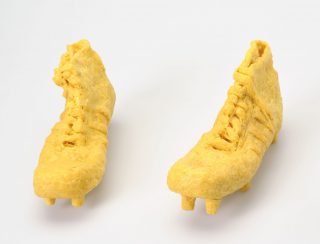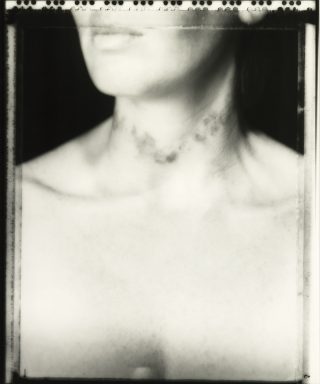It’s nearly the appointed hour and I’m panicking. I begin to fold washing, but it’s still damp, so I resort to shunting the drying rack out of frame. I rotate a pot plant, so its handsome new leaf is on display. I nudge a painting straight, consider hanging another, reposition my computer on top of a stack of books, in order to improve the camera angle. For many years, Angela Tiatia and I lived in the same city, Tāmaki Makaurau Auckland. We have various friends in common. I have long admired her artistic practice and have even included her work in an exhibition. We’ve communicated a handful of times via email, but we’ve never actually met. Today that changes. Sort of. Today—in preparation for writing on her new video work, Narcissus—we are to introduce ourselves via Skype.
At the best of times, I’m nervous about meeting artists. I’m a ‘prolific talker’ if we’re being generous, an inveterate bulldozer if we’re being honest, and I worry about coming on too strong and blurting out ideas that are off the mark. Moreover, I’m bothered by the mediation of the camera. I can’t help but want to manage my image, as I would for a photograph. As Tiatia and I talk, my eyes keep darting up to the little me in the corner of the screen. Even as it becomes apparent that my understanding of her work is in sympathy with her intentions, and even as we slip into easier conversation, I’m stuck on surveying myself. Yet, somehow, the awful aptness of my behaviour doesn’t occur to me until right near the end of our exchange, when the artist mentions a notion, put forward by Stephen Fry, about the true constitution of narcissism:
Perhaps narcissism is best defined as a need to look on other people as mirrored surfaces who satisfy us only when they reflect back a loving or admiring image of ourselves. When we look into another’s eyes, in other words, we are not looking to see who they are, but how we are reflected in their eyes.[1]
Narcissism has become intimately bound up with the internet. The 21st-century narcissist is a creature of social media, whether a vainglorious fusspot on Skype, an Instagram star growing a legion of followers for love or money, or a less glamourous user who spends more time composing their own witty tweets than engaging with the tweets of others. The decrying of online narcissism has become as common—and as much of a cliché—as the zealous promotion of social media’s ‘transformative potential’ once was. The artist wishing to explore the phenomenon thus faces a conundrum. How to avoid lapsing into the artistic equivalent of the aphorism under the post-workout selfie: speaking a truth so obvious that it becomes cringe-inducing and easy to ignore?
Tiatia finds a novel solution in the ancient. Drawing on the foundational Greco-Roman myth, in which the youthful Narcissus falls in love with his own image reflected in a pool, she develops a poignant and textured allegory for the present day. Tiatia’s interest in the allegorical is not new. Her 2017 video work The Fall took as its departure point the accounts of survivors of the 1942 Fall of Singapore; however, it consciously eschewed literal interpretation, instead presenting an abstracted societal collapse, redolent of occurrences real and fictive, past and impending. Narcissus is similarly untethered from time, emphasising the fact that narcissistic tendencies are no recent invention, and cleverly skirting the peril of the hackneyed contemporary.

Angela Tiatia, Narcissus (video still), 2019. Image courtesy of the artist and Sullivan+Strumpf, Singapore and Sydney.
Soundless and in slow motion, the film integrates elements from a host of artistic and literary sources.[2] The initial pose of the focal figure—the logical Narcissus—is borrowed from a 1597–9 painting by Michelangelo Merisi da Caravaggio. Tiatia’s choice of Caravaggio strikes me as significant. On the one hand, he’s an appealing example for the artist of today, possessing a unique and forward-looking vision backed up by a strong will (he insisted, for instance, on depicting the dead Virgin Mary as a real woman: pallid, barefoot, and lying in an inelegant position). On the other hand, he’s a famously flawed hero, an individual of violent temper, who was forced to flee Rome after killing a man—possibly by accident—in a brawl.
Caravaggio is complex: proud, yet able to please when necessary, producing sumptuous paintings for powerful and wealthy patrons like Cardinal Francesco Maria del Monte. Many of his best-loved works, Narcissus included, belong to a class of Baroque art-making that was ostensibly intended to point out human fallibility, and provide moral lessons, but was also a source of great sensual delight for audiences as enthusiastic for the erotic as for the loftier teachings of classical literature. I’m reminded that Narcissus enthralled others before becoming in thrall to himself. No egotist exists in a vacuum and there’s more than one way to swell an ego. Narcissus is a model flattered by an artist. He’s an artist railing against critical neglect or ramping up the price for a commission because he can. He’s a patron collecting accolades and titles as eagerly as he hoards treasures.
In accordance with tradition, Tiatia’s Narcissus is an exceptionally beautiful youth, festooned with a corona of Apollonian curls.[3] Although dressed in a contemporary buttoned shirt, he slips through time. He’d not look out of place on a Caravaggio canvas, nor in the 1986 film about the painter by Derek Jarman, nor on a 2019 catwalk. His is an allure for the ages—a quiet reminder (à la Germaine Greer) that boys, like women, have long been subjected to hungry eyes. Resting on his palms, elbows bent, he gazes into a dark body of water that seems to double as a river of Hades. In his Metamorposes, Ovid has it that Narcissus continued to gaze at his reflection in the river Styx following his death.[4] But I am tempted to think of the water as the oblivion-inducing Lethe, reinforcing the notion that excessive self-absorption can lead us to forget others and their needs.
A large number of others are arrayed around and behind Narcissus.[5] Occupying a shallow space, and maintaining the same basic configuration throughout, they lend the work the air of a tableau vivant: partway between a pictorial or sculptural arrangement and a conventional drama. The figures at first appear secondary, a Greek chorus there to reiterate the star’s narrative. As the video progresses, however, their individuality becomes more apparent. They rage and fight amongst themselves. Yet their identities remain opaque. They might be a supporting cast plucked from Ovid: Narcissus’s mother Liriope, his erstwhile pursuer Echo (the sonic reflection), fellow nymphs. They might be elements of Narcissus’s personality or embodiments of his demons. They might be kindred narcissists, who occupy a single platform while disregarding their fellows.
During our Skype interview, Tiatia makes brief mention of the ‘tribal self’. The current of conversation flows on, but, later, I find myself returning to the expression. Fed daily on a diet of American podcasts, I want to interpret it as related to ‘tribalism’. Despite (or perhaps because of) its enduring association with indigeneity, this term tends to carry a negative meaning today, as when it is used to describe the schism between Trump-supporters and -opponents. The tribal self is quite different. Credited to the 19th-century British philosopher William Kingdon Clifford (an interesting if not unproblematic thinker), it refers not to a retreat into parochialism but to the sociability, and social generosity, inherent in the human being: ‘the tribal self is incarnate in nothing less than humanity’.[6]
If the individuals in Tiatia’s video are in a state of chaos, they are nevertheless all in it together, and they can choose to derive strength from the kinship that already characterises them. Focussing—as so many of us so often do—on the failings of social media, it is all too easy to forget that these media have made substantial contributions to 21st-century life, providing platforms for voices previously more marginalised and facilitating the development of borderless communities based on shared experiences and values rather than, say, genetic or national affiliations. For example, reflecting on the use of Twitter by people from the Pacific, Lana Lopesi recently observed that it ‘is a tool of self-determination, in which Moana users assert and promote their own cultural identities’.[7]
This is not to downplay the many problems associated with the internet. As the recent and unutterably horrific terrorist attack in Ōtautahi Christchurch has made clear, online spaces can be deeply dangerous, spreading the most monstrous incarnations of self-pride. But such spaces can also shore up networks of solidarity, allowing us to share our heartbreak and to organise demonstrations of empathy that are greater, more enduring, and more truly of our species. We are now, perhaps more than ever before, capable of activating our compassion, provided we can see in others not just reflections of ourselves, but other selves: people as complex as we know ourselves to be. People deserving of our deepest regard.
*
Essay commissioned by Angela Tiatia. An abbreviated version appears in Art Collector 88 (April–June 2019): 166–171.
Narcissus
Angela Tiatia
22 March to 20 April 2019
Sullivan+Strumpf
Sydney, Australia
[1] Stephen Fry, Mythos (London: Michael Joseph, 2018), 344.
[2] Tiatia mentions, for example, works by Henri Cartier-Bresson, Philip-Lorca diCorcia, and Bill Viola. I can’t help but think of Rogier van der Weyden’s The Descent from the Cross (c. 1430s).
[3] See, for example, Ovid, The Metamorphoses of Ovid, trans. Michael Simpson (Amherst and Boston: University of Massachusetts Press, 2001), 54.
[4] Ovid, The Metamorphoses of Ovid, 55.
[5] Tiatia’s works have often centred on herself, on her body, exploring questions of representation and sovereignty. Here, she is absent. She does not even make a cameo appearance, as she did in The Fall.
[6] William Kingdon Clifford, ‘On the Scientific Basis of Morals’, in Lectures and Essays, vol. 2, ed. Leslie Stephen and Frederick Pollock (London: Macmillan and Co., 1897), 112.
[7] Lana Lopesi, False Divides (Wellington: Bridget Williams Books, 2018), 83.




